Managerial Economics: OPEC, Demand, Supply and Market Analysis
VerifiedAdded on 2023/06/13
|12
|2802
|195
Report
AI Summary
This report provides a detailed analysis of several key concepts in managerial economics. It begins by examining the decisions made at a recent OPEC meeting and their subsequent impact on global oil supply and demand, considering factors such as production restrictions, public transport closures due to COVID-19, advancements in electric battery technology, and the discovery of new oil fields. The report then explores how changes in the number of entrepreneurs and consumers affect demand curves, followed by an explanation of the impact of price ceilings on heating gas prices in Europe. Furthermore, it calculates and analyzes equilibrium prices and quantities in a restaurant setting, including scenarios with cost reductions. The report also includes cost analysis, calculating total cost, average variable cost, average total cost, and marginal cost. Finally, the report critically evaluates the characteristics and equilibrium points of perfect competition, discussing shutdown points and equilibrium situations, highlighting the theoretical aspects and real-world limitations of this market structure. Students can find similar solved assignments and resources on Desklib.
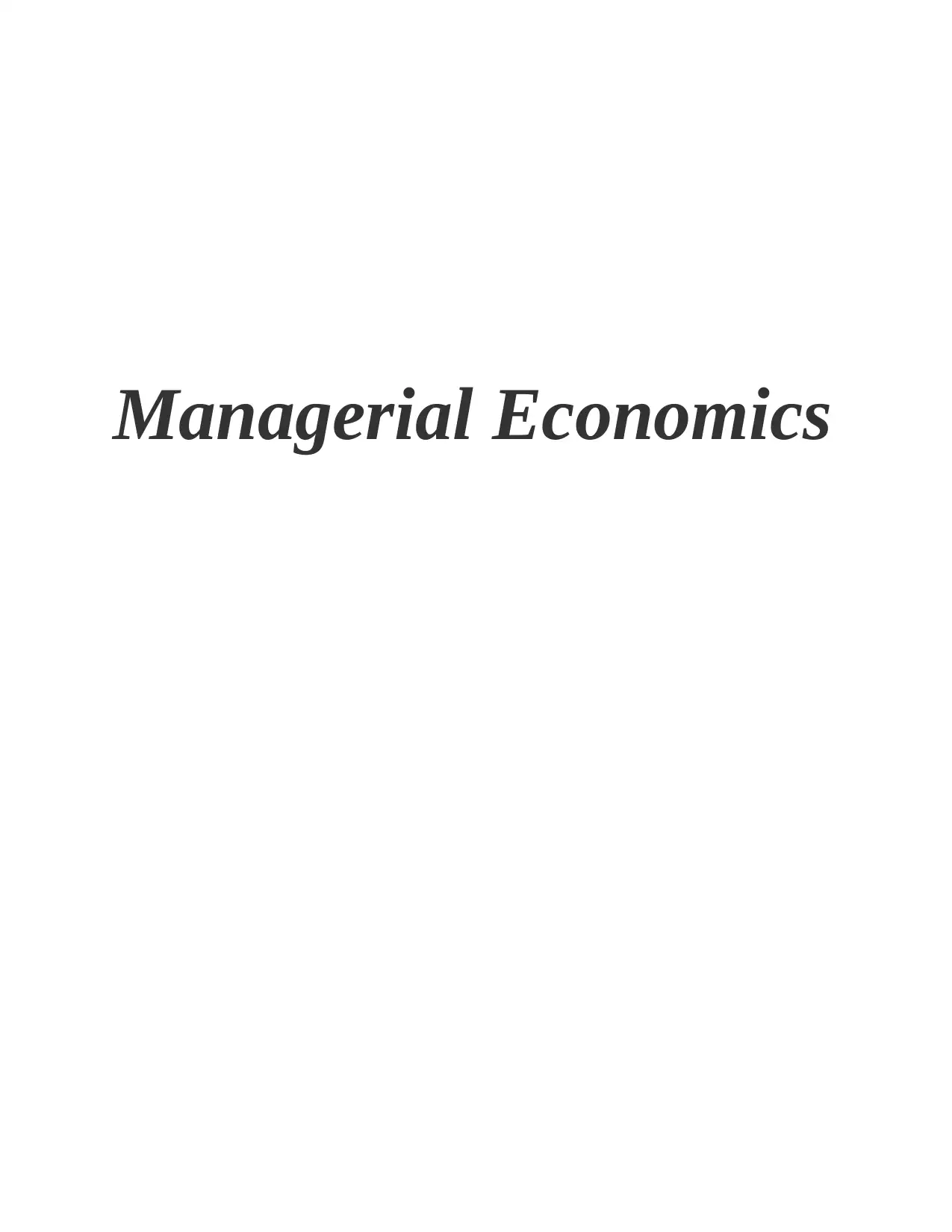
Managerial Economics
Paraphrase This Document
Need a fresh take? Get an instant paraphrase of this document with our AI Paraphraser
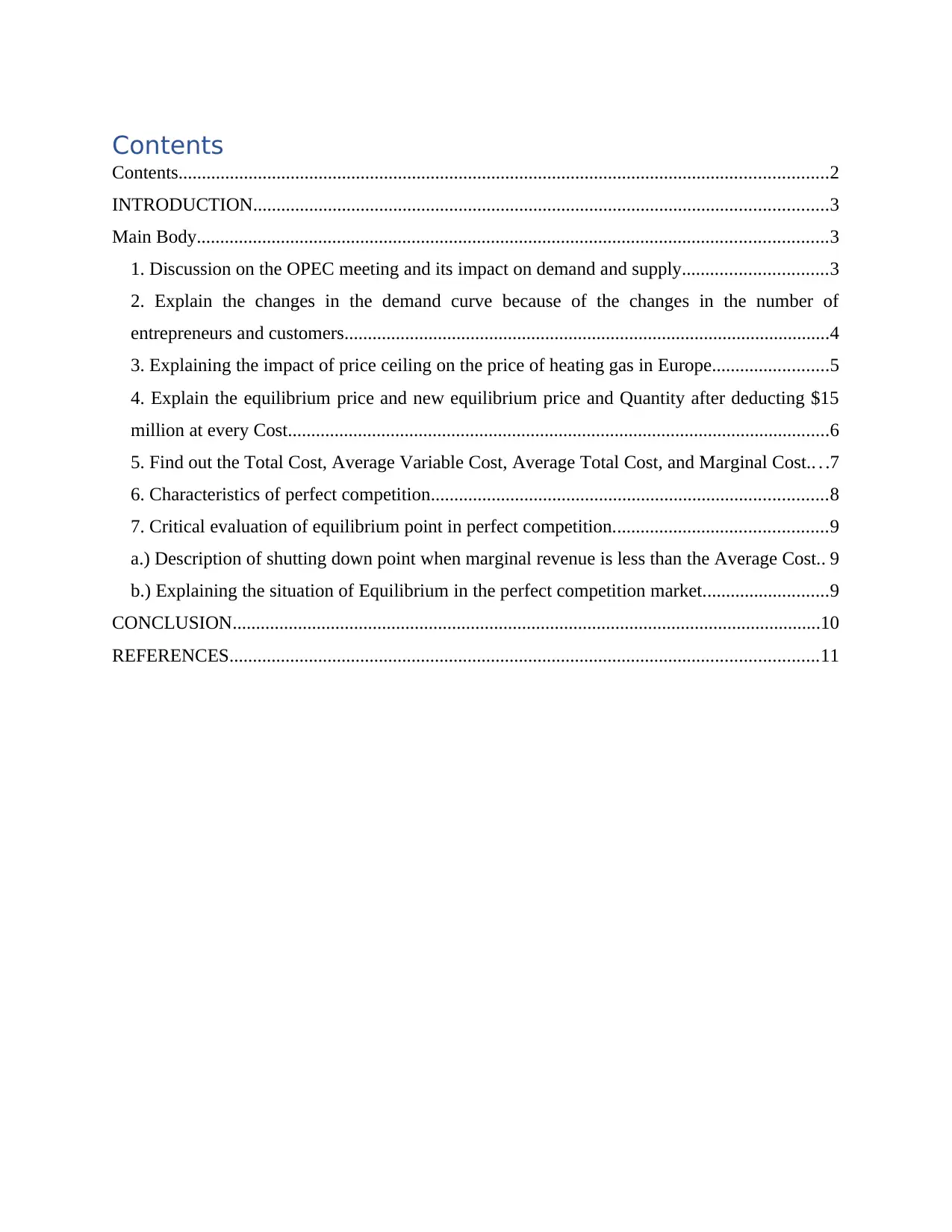
Contents
Contents...........................................................................................................................................2
INTRODUCTION...........................................................................................................................3
Main Body.......................................................................................................................................3
1. Discussion on the OPEC meeting and its impact on demand and supply...............................3
2. Explain the changes in the demand curve because of the changes in the number of
entrepreneurs and customers........................................................................................................4
3. Explaining the impact of price ceiling on the price of heating gas in Europe.........................5
4. Explain the equilibrium price and new equilibrium price and Quantity after deducting $15
million at every Cost....................................................................................................................6
5. Find out the Total Cost, Average Variable Cost, Average Total Cost, and Marginal Cost.. . .7
6. Characteristics of perfect competition.....................................................................................8
7. Critical evaluation of equilibrium point in perfect competition..............................................9
a.) Description of shutting down point when marginal revenue is less than the Average Cost.. 9
b.) Explaining the situation of Equilibrium in the perfect competition market...........................9
CONCLUSION..............................................................................................................................10
REFERENCES..............................................................................................................................11
Contents...........................................................................................................................................2
INTRODUCTION...........................................................................................................................3
Main Body.......................................................................................................................................3
1. Discussion on the OPEC meeting and its impact on demand and supply...............................3
2. Explain the changes in the demand curve because of the changes in the number of
entrepreneurs and customers........................................................................................................4
3. Explaining the impact of price ceiling on the price of heating gas in Europe.........................5
4. Explain the equilibrium price and new equilibrium price and Quantity after deducting $15
million at every Cost....................................................................................................................6
5. Find out the Total Cost, Average Variable Cost, Average Total Cost, and Marginal Cost.. . .7
6. Characteristics of perfect competition.....................................................................................8
7. Critical evaluation of equilibrium point in perfect competition..............................................9
a.) Description of shutting down point when marginal revenue is less than the Average Cost.. 9
b.) Explaining the situation of Equilibrium in the perfect competition market...........................9
CONCLUSION..............................................................................................................................10
REFERENCES..............................................................................................................................11
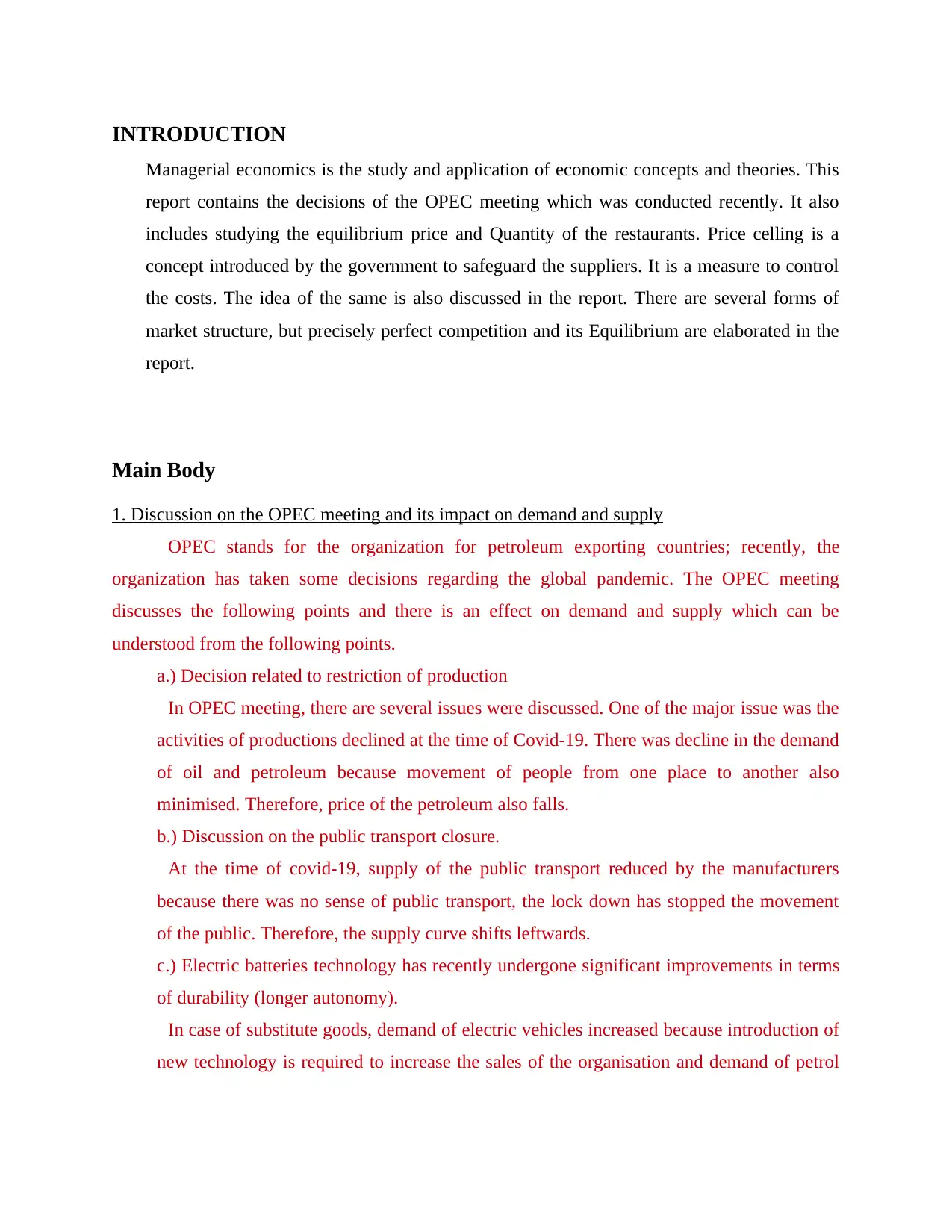
INTRODUCTION
Managerial economics is the study and application of economic concepts and theories. This
report contains the decisions of the OPEC meeting which was conducted recently. It also
includes studying the equilibrium price and Quantity of the restaurants. Price celling is a
concept introduced by the government to safeguard the suppliers. It is a measure to control
the costs. The idea of the same is also discussed in the report. There are several forms of
market structure, but precisely perfect competition and its Equilibrium are elaborated in the
report.
Main Body
1. Discussion on the OPEC meeting and its impact on demand and supply
OPEC stands for the organization for petroleum exporting countries; recently, the
organization has taken some decisions regarding the global pandemic. The OPEC meeting
discusses the following points and there is an effect on demand and supply which can be
understood from the following points.
a.) Decision related to restriction of production
In OPEC meeting, there are several issues were discussed. One of the major issue was the
activities of productions declined at the time of Covid-19. There was decline in the demand
of oil and petroleum because movement of people from one place to another also
minimised. Therefore, price of the petroleum also falls.
b.) Discussion on the public transport closure.
At the time of covid-19, supply of the public transport reduced by the manufacturers
because there was no sense of public transport, the lock down has stopped the movement
of the public. Therefore, the supply curve shifts leftwards.
c.) Electric batteries technology has recently undergone significant improvements in terms
of durability (longer autonomy).
In case of substitute goods, demand of electric vehicles increased because introduction of
new technology is required to increase the sales of the organisation and demand of petrol
Managerial economics is the study and application of economic concepts and theories. This
report contains the decisions of the OPEC meeting which was conducted recently. It also
includes studying the equilibrium price and Quantity of the restaurants. Price celling is a
concept introduced by the government to safeguard the suppliers. It is a measure to control
the costs. The idea of the same is also discussed in the report. There are several forms of
market structure, but precisely perfect competition and its Equilibrium are elaborated in the
report.
Main Body
1. Discussion on the OPEC meeting and its impact on demand and supply
OPEC stands for the organization for petroleum exporting countries; recently, the
organization has taken some decisions regarding the global pandemic. The OPEC meeting
discusses the following points and there is an effect on demand and supply which can be
understood from the following points.
a.) Decision related to restriction of production
In OPEC meeting, there are several issues were discussed. One of the major issue was the
activities of productions declined at the time of Covid-19. There was decline in the demand
of oil and petroleum because movement of people from one place to another also
minimised. Therefore, price of the petroleum also falls.
b.) Discussion on the public transport closure.
At the time of covid-19, supply of the public transport reduced by the manufacturers
because there was no sense of public transport, the lock down has stopped the movement
of the public. Therefore, the supply curve shifts leftwards.
c.) Electric batteries technology has recently undergone significant improvements in terms
of durability (longer autonomy).
In case of substitute goods, demand of electric vehicles increased because introduction of
new technology is required to increase the sales of the organisation and demand of petrol
You're viewing a preview
Unlock full access by subscribing today!
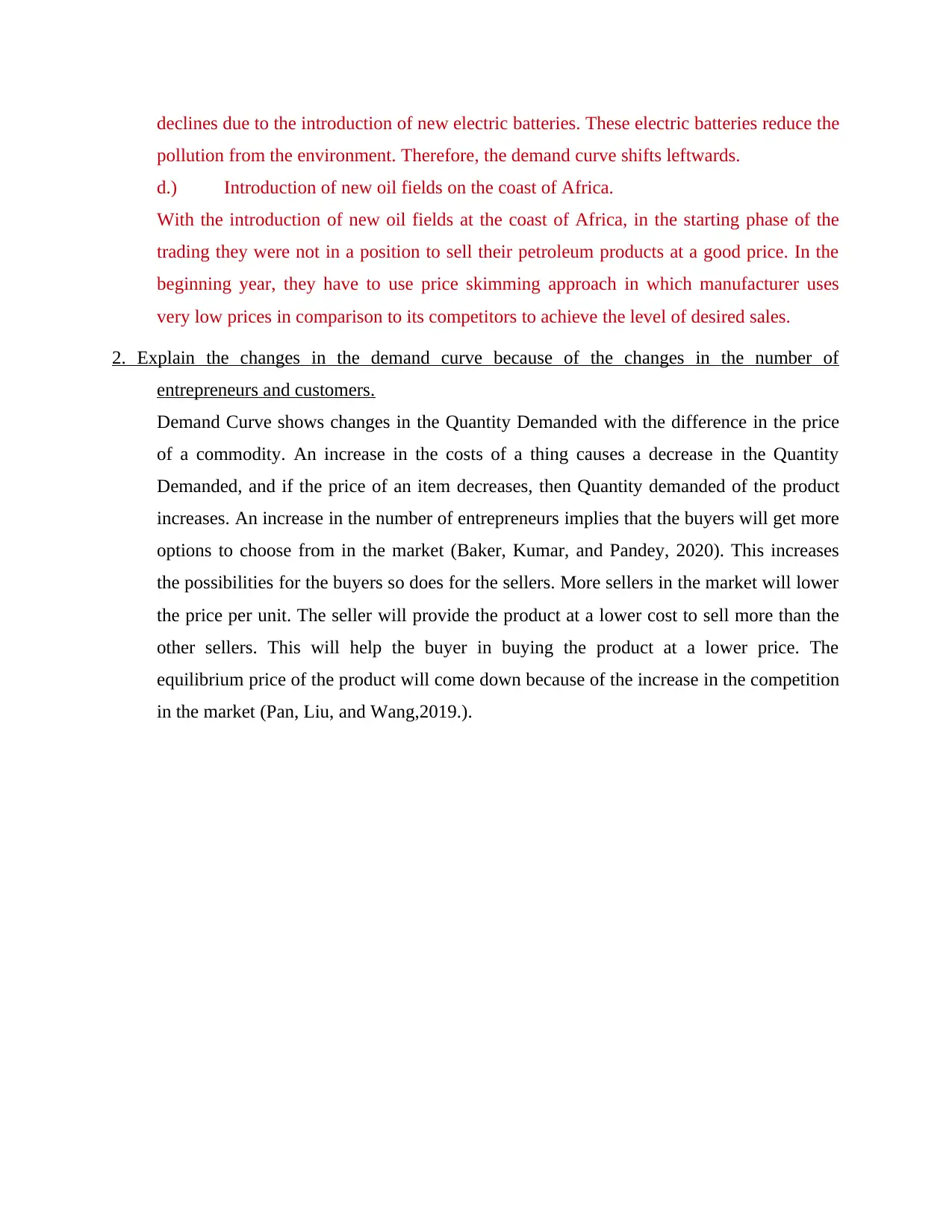
declines due to the introduction of new electric batteries. These electric batteries reduce the
pollution from the environment. Therefore, the demand curve shifts leftwards.
d.) Introduction of new oil fields on the coast of Africa.
With the introduction of new oil fields at the coast of Africa, in the starting phase of the
trading they were not in a position to sell their petroleum products at a good price. In the
beginning year, they have to use price skimming approach in which manufacturer uses
very low prices in comparison to its competitors to achieve the level of desired sales.
2. Explain the changes in the demand curve because of the changes in the number of
entrepreneurs and customers.
Demand Curve shows changes in the Quantity Demanded with the difference in the price
of a commodity. An increase in the costs of a thing causes a decrease in the Quantity
Demanded, and if the price of an item decreases, then Quantity demanded of the product
increases. An increase in the number of entrepreneurs implies that the buyers will get more
options to choose from in the market (Baker, Kumar, and Pandey, 2020). This increases
the possibilities for the buyers so does for the sellers. More sellers in the market will lower
the price per unit. The seller will provide the product at a lower cost to sell more than the
other sellers. This will help the buyer in buying the product at a lower price. The
equilibrium price of the product will come down because of the increase in the competition
in the market (Pan, Liu, and Wang,2019.).
pollution from the environment. Therefore, the demand curve shifts leftwards.
d.) Introduction of new oil fields on the coast of Africa.
With the introduction of new oil fields at the coast of Africa, in the starting phase of the
trading they were not in a position to sell their petroleum products at a good price. In the
beginning year, they have to use price skimming approach in which manufacturer uses
very low prices in comparison to its competitors to achieve the level of desired sales.
2. Explain the changes in the demand curve because of the changes in the number of
entrepreneurs and customers.
Demand Curve shows changes in the Quantity Demanded with the difference in the price
of a commodity. An increase in the costs of a thing causes a decrease in the Quantity
Demanded, and if the price of an item decreases, then Quantity demanded of the product
increases. An increase in the number of entrepreneurs implies that the buyers will get more
options to choose from in the market (Baker, Kumar, and Pandey, 2020). This increases
the possibilities for the buyers so does for the sellers. More sellers in the market will lower
the price per unit. The seller will provide the product at a lower cost to sell more than the
other sellers. This will help the buyer in buying the product at a lower price. The
equilibrium price of the product will come down because of the increase in the competition
in the market (Pan, Liu, and Wang,2019.).
Paraphrase This Document
Need a fresh take? Get an instant paraphrase of this document with our AI Paraphraser
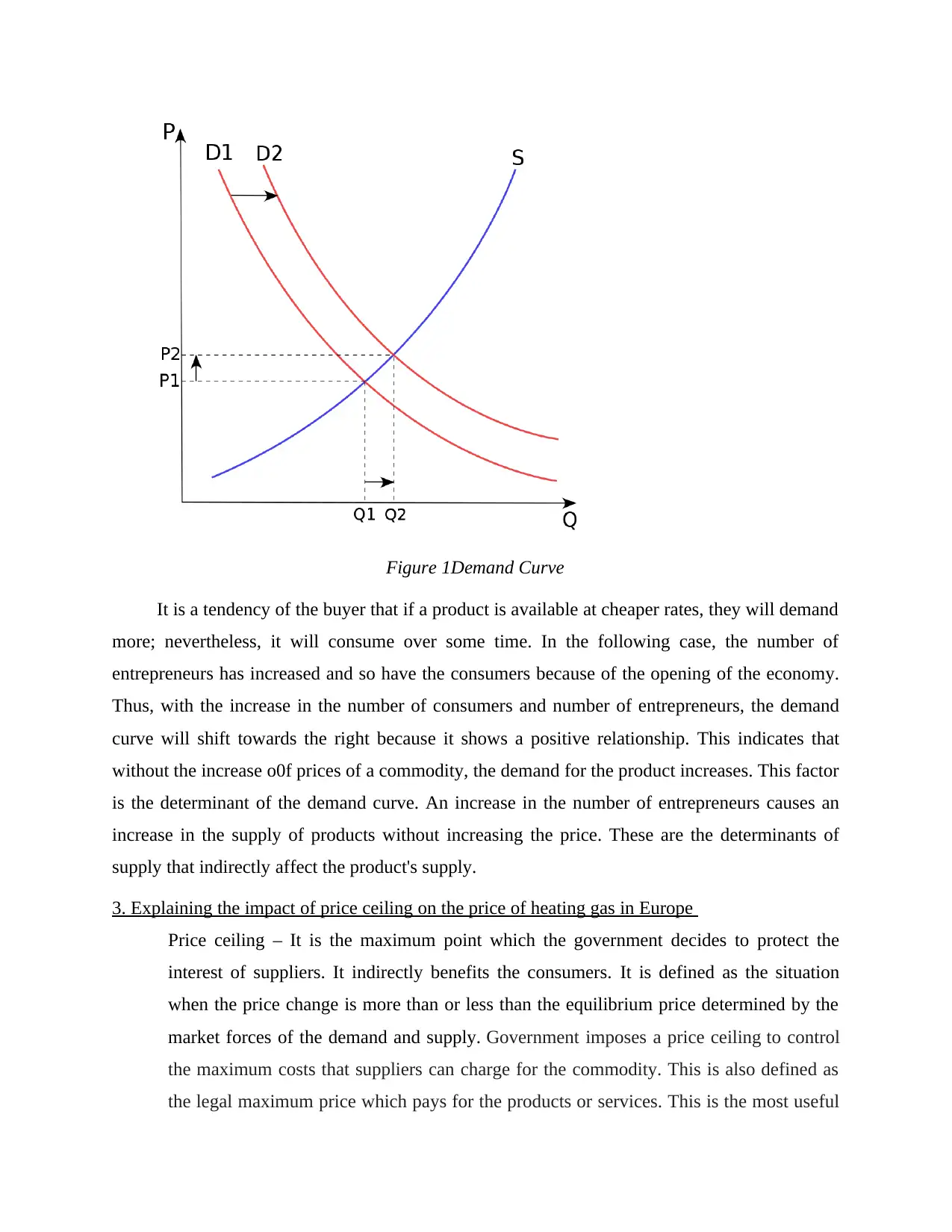
Figure 1Demand Curve
It is a tendency of the buyer that if a product is available at cheaper rates, they will demand
more; nevertheless, it will consume over some time. In the following case, the number of
entrepreneurs has increased and so have the consumers because of the opening of the economy.
Thus, with the increase in the number of consumers and number of entrepreneurs, the demand
curve will shift towards the right because it shows a positive relationship. This indicates that
without the increase o0f prices of a commodity, the demand for the product increases. This factor
is the determinant of the demand curve. An increase in the number of entrepreneurs causes an
increase in the supply of products without increasing the price. These are the determinants of
supply that indirectly affect the product's supply.
3. Explaining the impact of price ceiling on the price of heating gas in Europe
Price ceiling – It is the maximum point which the government decides to protect the
interest of suppliers. It indirectly benefits the consumers. It is defined as the situation
when the price change is more than or less than the equilibrium price determined by the
market forces of the demand and supply. Government imposes a price ceiling to control
the maximum costs that suppliers can charge for the commodity. This is also defined as
the legal maximum price which pays for the products or services. This is the most useful
It is a tendency of the buyer that if a product is available at cheaper rates, they will demand
more; nevertheless, it will consume over some time. In the following case, the number of
entrepreneurs has increased and so have the consumers because of the opening of the economy.
Thus, with the increase in the number of consumers and number of entrepreneurs, the demand
curve will shift towards the right because it shows a positive relationship. This indicates that
without the increase o0f prices of a commodity, the demand for the product increases. This factor
is the determinant of the demand curve. An increase in the number of entrepreneurs causes an
increase in the supply of products without increasing the price. These are the determinants of
supply that indirectly affect the product's supply.
3. Explaining the impact of price ceiling on the price of heating gas in Europe
Price ceiling – It is the maximum point which the government decides to protect the
interest of suppliers. It indirectly benefits the consumers. It is defined as the situation
when the price change is more than or less than the equilibrium price determined by the
market forces of the demand and supply. Government imposes a price ceiling to control
the maximum costs that suppliers can charge for the commodity. This is also defined as
the legal maximum price which pays for the products or services. This is the most useful
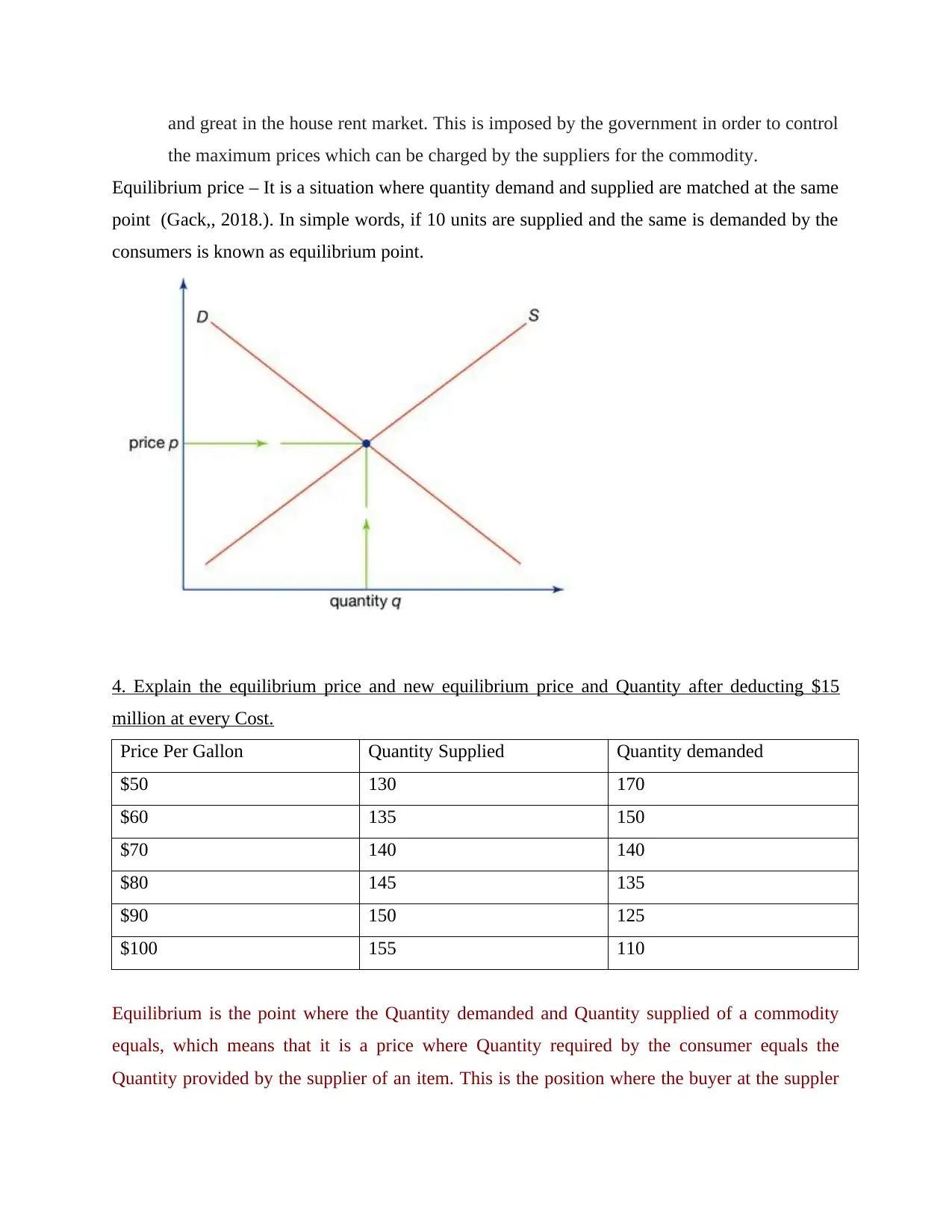
and great in the house rent market. This is imposed by the government in order to control
the maximum prices which can be charged by the suppliers for the commodity.
Equilibrium price – It is a situation where quantity demand and supplied are matched at the same
point (Gack,, 2018.). In simple words, if 10 units are supplied and the same is demanded by the
consumers is known as equilibrium point.
4. Explain the equilibrium price and new equilibrium price and Quantity after deducting $15
million at every Cost.
Price Per Gallon Quantity Supplied Quantity demanded
$50 130 170
$60 135 150
$70 140 140
$80 145 135
$90 150 125
$100 155 110
Equilibrium is the point where the Quantity demanded and Quantity supplied of a commodity
equals, which means that it is a price where Quantity required by the consumer equals the
Quantity provided by the supplier of an item. This is the position where the buyer at the suppler
the maximum prices which can be charged by the suppliers for the commodity.
Equilibrium price – It is a situation where quantity demand and supplied are matched at the same
point (Gack,, 2018.). In simple words, if 10 units are supplied and the same is demanded by the
consumers is known as equilibrium point.
4. Explain the equilibrium price and new equilibrium price and Quantity after deducting $15
million at every Cost.
Price Per Gallon Quantity Supplied Quantity demanded
$50 130 170
$60 135 150
$70 140 140
$80 145 135
$90 150 125
$100 155 110
Equilibrium is the point where the Quantity demanded and Quantity supplied of a commodity
equals, which means that it is a price where Quantity required by the consumer equals the
Quantity provided by the supplier of an item. This is the position where the buyer at the suppler
You're viewing a preview
Unlock full access by subscribing today!
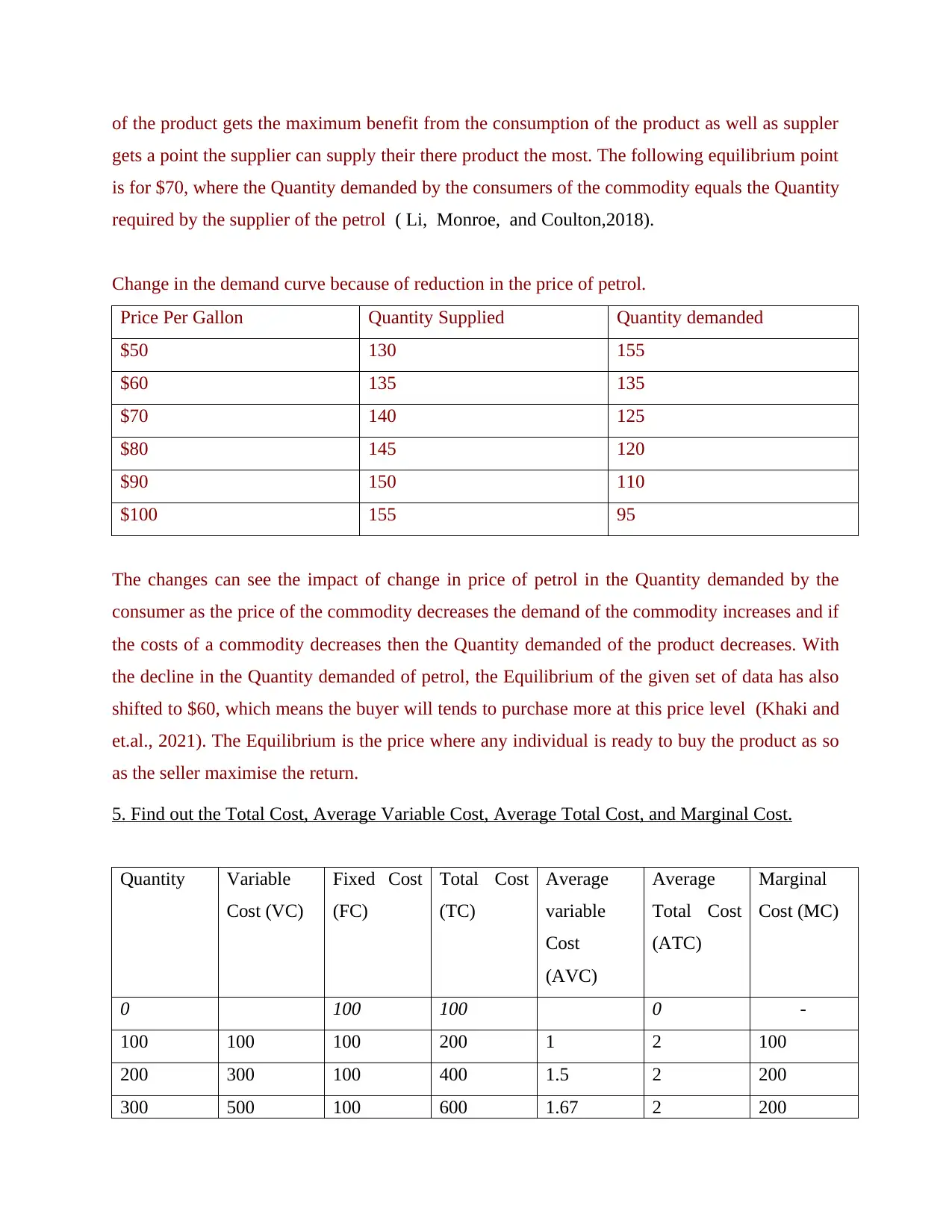
of the product gets the maximum benefit from the consumption of the product as well as suppler
gets a point the supplier can supply their there product the most. The following equilibrium point
is for $70, where the Quantity demanded by the consumers of the commodity equals the Quantity
required by the supplier of the petrol ( Li, Monroe, and Coulton,2018).
Change in the demand curve because of reduction in the price of petrol.
Price Per Gallon Quantity Supplied Quantity demanded
$50 130 155
$60 135 135
$70 140 125
$80 145 120
$90 150 110
$100 155 95
The changes can see the impact of change in price of petrol in the Quantity demanded by the
consumer as the price of the commodity decreases the demand of the commodity increases and if
the costs of a commodity decreases then the Quantity demanded of the product decreases. With
the decline in the Quantity demanded of petrol, the Equilibrium of the given set of data has also
shifted to $60, which means the buyer will tends to purchase more at this price level (Khaki and
et.al., 2021). The Equilibrium is the price where any individual is ready to buy the product as so
as the seller maximise the return.
5. Find out the Total Cost, Average Variable Cost, Average Total Cost, and Marginal Cost.
Quantity Variable
Cost (VC)
Fixed Cost
(FC)
Total Cost
(TC)
Average
variable
Cost
(AVC)
Average
Total Cost
(ATC)
Marginal
Cost (MC)
0 100 100 0 -
100 100 100 200 1 2 100
200 300 100 400 1.5 2 200
300 500 100 600 1.67 2 200
gets a point the supplier can supply their there product the most. The following equilibrium point
is for $70, where the Quantity demanded by the consumers of the commodity equals the Quantity
required by the supplier of the petrol ( Li, Monroe, and Coulton,2018).
Change in the demand curve because of reduction in the price of petrol.
Price Per Gallon Quantity Supplied Quantity demanded
$50 130 155
$60 135 135
$70 140 125
$80 145 120
$90 150 110
$100 155 95
The changes can see the impact of change in price of petrol in the Quantity demanded by the
consumer as the price of the commodity decreases the demand of the commodity increases and if
the costs of a commodity decreases then the Quantity demanded of the product decreases. With
the decline in the Quantity demanded of petrol, the Equilibrium of the given set of data has also
shifted to $60, which means the buyer will tends to purchase more at this price level (Khaki and
et.al., 2021). The Equilibrium is the price where any individual is ready to buy the product as so
as the seller maximise the return.
5. Find out the Total Cost, Average Variable Cost, Average Total Cost, and Marginal Cost.
Quantity Variable
Cost (VC)
Fixed Cost
(FC)
Total Cost
(TC)
Average
variable
Cost
(AVC)
Average
Total Cost
(ATC)
Marginal
Cost (MC)
0 100 100 0 -
100 100 100 200 1 2 100
200 300 100 400 1.5 2 200
300 500 100 600 1.67 2 200
Paraphrase This Document
Need a fresh take? Get an instant paraphrase of this document with our AI Paraphraser
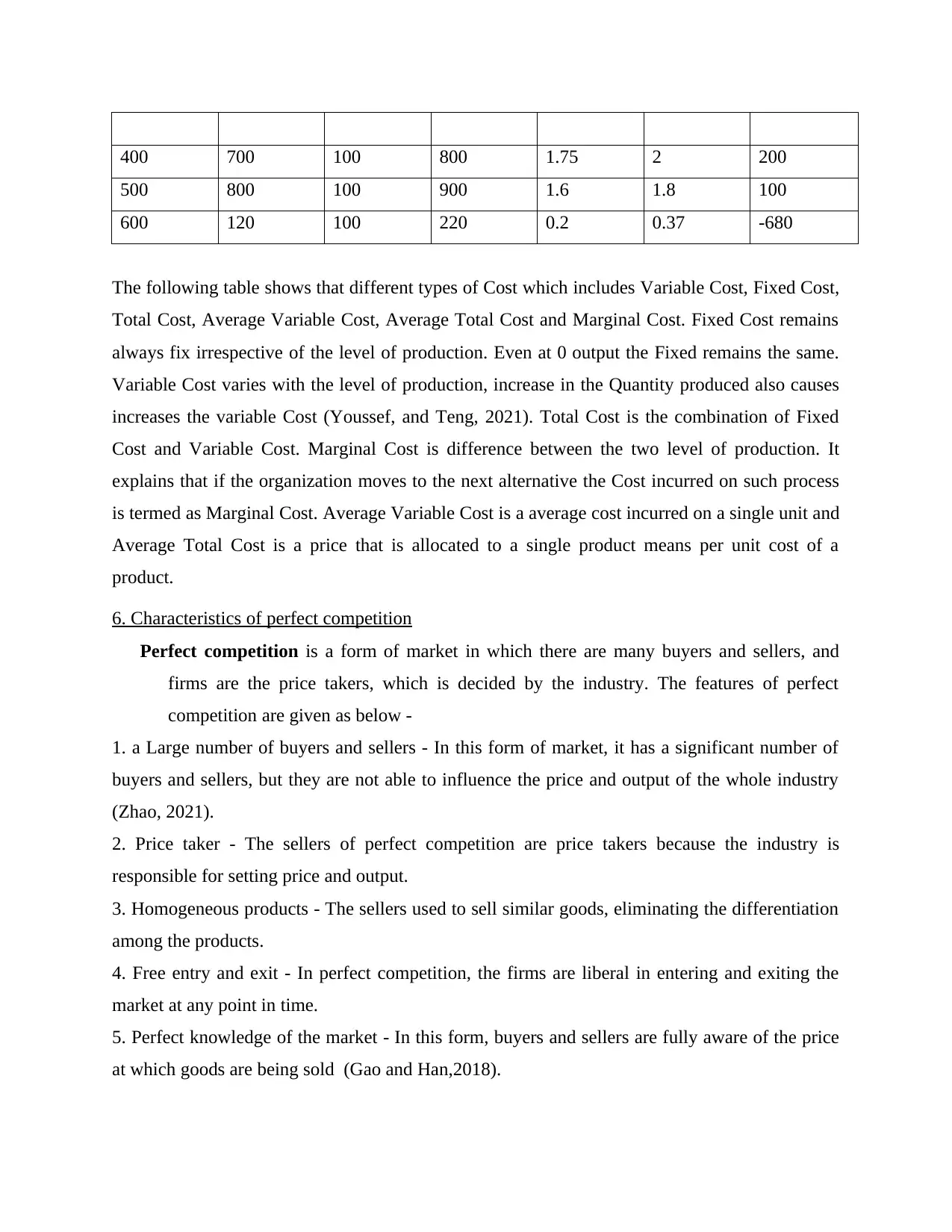
400 700 100 800 1.75 2 200
500 800 100 900 1.6 1.8 100
600 120 100 220 0.2 0.37 -680
The following table shows that different types of Cost which includes Variable Cost, Fixed Cost,
Total Cost, Average Variable Cost, Average Total Cost and Marginal Cost. Fixed Cost remains
always fix irrespective of the level of production. Even at 0 output the Fixed remains the same.
Variable Cost varies with the level of production, increase in the Quantity produced also causes
increases the variable Cost (Youssef, and Teng, 2021). Total Cost is the combination of Fixed
Cost and Variable Cost. Marginal Cost is difference between the two level of production. It
explains that if the organization moves to the next alternative the Cost incurred on such process
is termed as Marginal Cost. Average Variable Cost is a average cost incurred on a single unit and
Average Total Cost is a price that is allocated to a single product means per unit cost of a
product.
6. Characteristics of perfect competition
Perfect competition is a form of market in which there are many buyers and sellers, and
firms are the price takers, which is decided by the industry. The features of perfect
competition are given as below -
1. a Large number of buyers and sellers - In this form of market, it has a significant number of
buyers and sellers, but they are not able to influence the price and output of the whole industry
(Zhao, 2021).
2. Price taker - The sellers of perfect competition are price takers because the industry is
responsible for setting price and output.
3. Homogeneous products - The sellers used to sell similar goods, eliminating the differentiation
among the products.
4. Free entry and exit - In perfect competition, the firms are liberal in entering and exiting the
market at any point in time.
5. Perfect knowledge of the market - In this form, buyers and sellers are fully aware of the price
at which goods are being sold (Gao and Han,2018).
500 800 100 900 1.6 1.8 100
600 120 100 220 0.2 0.37 -680
The following table shows that different types of Cost which includes Variable Cost, Fixed Cost,
Total Cost, Average Variable Cost, Average Total Cost and Marginal Cost. Fixed Cost remains
always fix irrespective of the level of production. Even at 0 output the Fixed remains the same.
Variable Cost varies with the level of production, increase in the Quantity produced also causes
increases the variable Cost (Youssef, and Teng, 2021). Total Cost is the combination of Fixed
Cost and Variable Cost. Marginal Cost is difference between the two level of production. It
explains that if the organization moves to the next alternative the Cost incurred on such process
is termed as Marginal Cost. Average Variable Cost is a average cost incurred on a single unit and
Average Total Cost is a price that is allocated to a single product means per unit cost of a
product.
6. Characteristics of perfect competition
Perfect competition is a form of market in which there are many buyers and sellers, and
firms are the price takers, which is decided by the industry. The features of perfect
competition are given as below -
1. a Large number of buyers and sellers - In this form of market, it has a significant number of
buyers and sellers, but they are not able to influence the price and output of the whole industry
(Zhao, 2021).
2. Price taker - The sellers of perfect competition are price takers because the industry is
responsible for setting price and output.
3. Homogeneous products - The sellers used to sell similar goods, eliminating the differentiation
among the products.
4. Free entry and exit - In perfect competition, the firms are liberal in entering and exiting the
market at any point in time.
5. Perfect knowledge of the market - In this form, buyers and sellers are fully aware of the price
at which goods are being sold (Gao and Han,2018).

There are some limitations of the perfect competition which restrict the same to apply in the real
world.
Similar products - The main feature which is difficult to exist is the homogeneity of
products. There is some degree of differentiation that always exists between the products.
In reality, it is rarer to observe identical goods.
Government regulations - The policies for starting a new venture restrict firms from free
entry because several start-up costs are included in the commencement process.
Free entry and exit of the firms – In real world, there are several formalities which are
required to be fulfilled but as the features of perfect competition suggest that entry is not
restricted which is not possible in actual conditions.
7. Critical evaluation of equilibrium point in perfect competition.
a.) Description of shutting down point when marginal revenue is less than the Average Cost.
There is the situation of losses in perfect competition, which can be understood from the
following points.
In the short term, there are three situations such as-
Expected profit- In perfect competition, average and marginal revenue remains constant.
Supernormal profit is when average income is more significant than average Cost
(Ochinowski, 2021).
Losses- In this situation, there is a point when the average price exceeds the average
revenue. This is a situation of loss.
Shut down - It is a situation where a firm experiences no advantages for the continuing
operation of the business, and an enterprise is stuck in a situation where the enterprise is
not recovering short-term variable costs.
b.) Explaining the situation of Equilibrium in the perfect competition market.
In the perfect competition market, there are broadly two situations of Equilibrium, which
are as follows-
MC=MR.
MC Cuts MR from below
1.) MC=MR: It states that firms continue their production until marginal cost and marginal
revenue cut others at the same point (Wang, Huang, and Jiang, 2020).
world.
Similar products - The main feature which is difficult to exist is the homogeneity of
products. There is some degree of differentiation that always exists between the products.
In reality, it is rarer to observe identical goods.
Government regulations - The policies for starting a new venture restrict firms from free
entry because several start-up costs are included in the commencement process.
Free entry and exit of the firms – In real world, there are several formalities which are
required to be fulfilled but as the features of perfect competition suggest that entry is not
restricted which is not possible in actual conditions.
7. Critical evaluation of equilibrium point in perfect competition.
a.) Description of shutting down point when marginal revenue is less than the Average Cost.
There is the situation of losses in perfect competition, which can be understood from the
following points.
In the short term, there are three situations such as-
Expected profit- In perfect competition, average and marginal revenue remains constant.
Supernormal profit is when average income is more significant than average Cost
(Ochinowski, 2021).
Losses- In this situation, there is a point when the average price exceeds the average
revenue. This is a situation of loss.
Shut down - It is a situation where a firm experiences no advantages for the continuing
operation of the business, and an enterprise is stuck in a situation where the enterprise is
not recovering short-term variable costs.
b.) Explaining the situation of Equilibrium in the perfect competition market.
In the perfect competition market, there are broadly two situations of Equilibrium, which
are as follows-
MC=MR.
MC Cuts MR from below
1.) MC=MR: It states that firms continue their production until marginal cost and marginal
revenue cut others at the same point (Wang, Huang, and Jiang, 2020).
You're viewing a preview
Unlock full access by subscribing today!
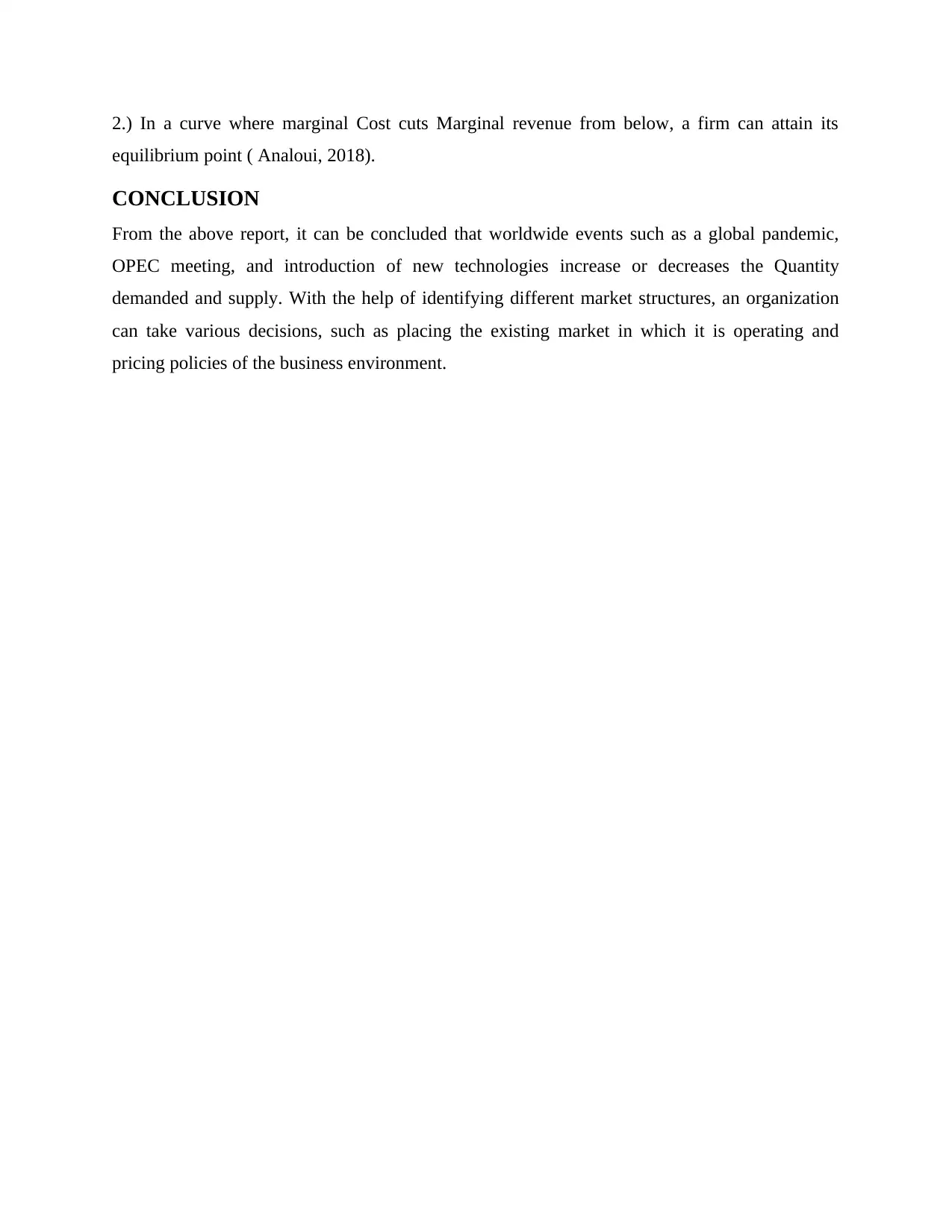
2.) In a curve where marginal Cost cuts Marginal revenue from below, a firm can attain its
equilibrium point ( Analoui, 2018).
CONCLUSION
From the above report, it can be concluded that worldwide events such as a global pandemic,
OPEC meeting, and introduction of new technologies increase or decreases the Quantity
demanded and supply. With the help of identifying different market structures, an organization
can take various decisions, such as placing the existing market in which it is operating and
pricing policies of the business environment.
equilibrium point ( Analoui, 2018).
CONCLUSION
From the above report, it can be concluded that worldwide events such as a global pandemic,
OPEC meeting, and introduction of new technologies increase or decreases the Quantity
demanded and supply. With the help of identifying different market structures, an organization
can take various decisions, such as placing the existing market in which it is operating and
pricing policies of the business environment.
Paraphrase This Document
Need a fresh take? Get an instant paraphrase of this document with our AI Paraphraser
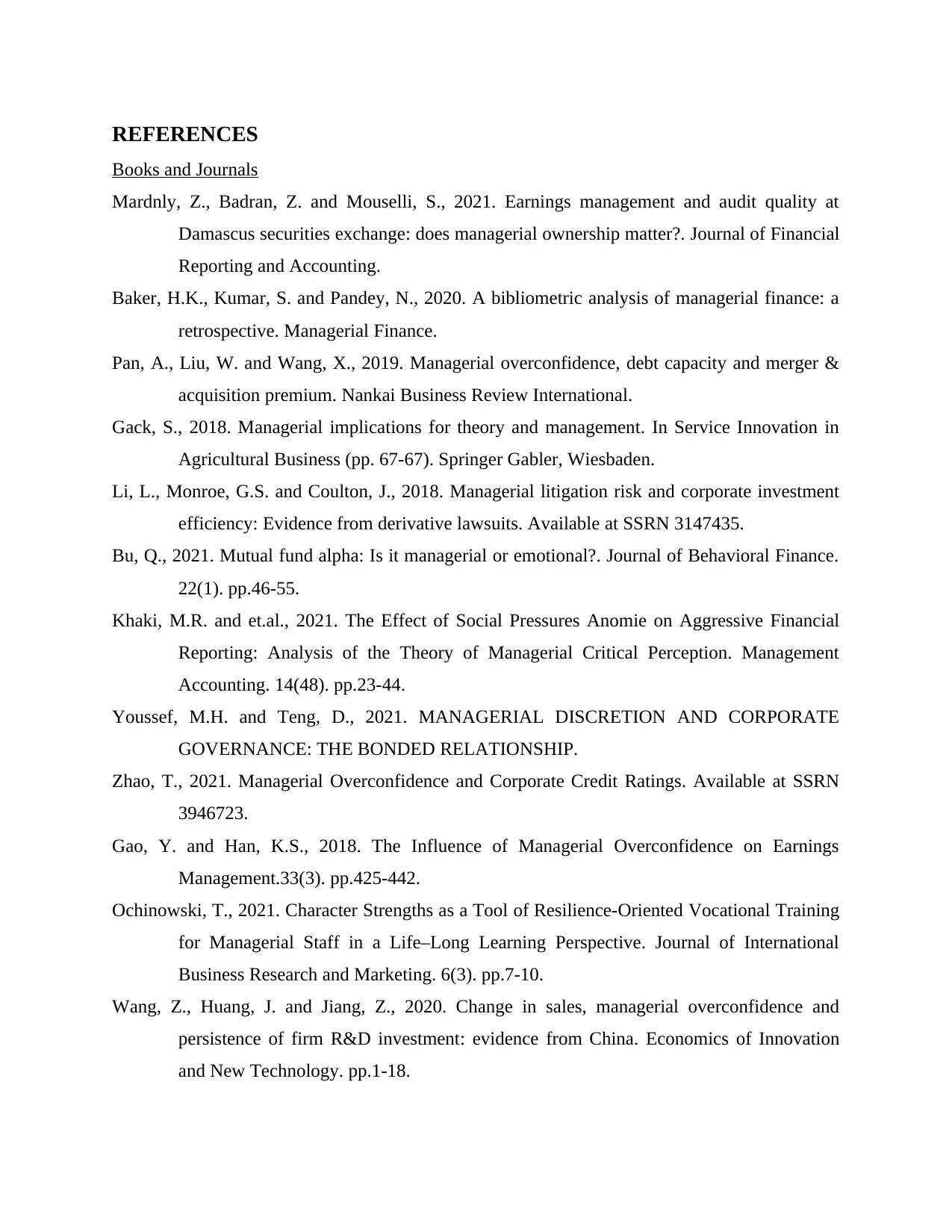
REFERENCES
Books and Journals
Mardnly, Z., Badran, Z. and Mouselli, S., 2021. Earnings management and audit quality at
Damascus securities exchange: does managerial ownership matter?. Journal of Financial
Reporting and Accounting.
Baker, H.K., Kumar, S. and Pandey, N., 2020. A bibliometric analysis of managerial finance: a
retrospective. Managerial Finance.
Pan, A., Liu, W. and Wang, X., 2019. Managerial overconfidence, debt capacity and merger &
acquisition premium. Nankai Business Review International.
Gack, S., 2018. Managerial implications for theory and management. In Service Innovation in
Agricultural Business (pp. 67-67). Springer Gabler, Wiesbaden.
Li, L., Monroe, G.S. and Coulton, J., 2018. Managerial litigation risk and corporate investment
efficiency: Evidence from derivative lawsuits. Available at SSRN 3147435.
Bu, Q., 2021. Mutual fund alpha: Is it managerial or emotional?. Journal of Behavioral Finance.
22(1). pp.46-55.
Khaki, M.R. and et.al., 2021. The Effect of Social Pressures Anomie on Aggressive Financial
Reporting: Analysis of the Theory of Managerial Critical Perception. Management
Accounting. 14(48). pp.23-44.
Youssef, M.H. and Teng, D., 2021. MANAGERIAL DISCRETION AND CORPORATE
GOVERNANCE: THE BONDED RELATIONSHIP.
Zhao, T., 2021. Managerial Overconfidence and Corporate Credit Ratings. Available at SSRN
3946723.
Gao, Y. and Han, K.S., 2018. The Influence of Managerial Overconfidence on Earnings
Management.33(3). pp.425-442.
Ochinowski, T., 2021. Character Strengths as a Tool of Resilience-Oriented Vocational Training
for Managerial Staff in a Life–Long Learning Perspective. Journal of International
Business Research and Marketing. 6(3). pp.7-10.
Wang, Z., Huang, J. and Jiang, Z., 2020. Change in sales, managerial overconfidence and
persistence of firm R&D investment: evidence from China. Economics of Innovation
and New Technology. pp.1-18.
Books and Journals
Mardnly, Z., Badran, Z. and Mouselli, S., 2021. Earnings management and audit quality at
Damascus securities exchange: does managerial ownership matter?. Journal of Financial
Reporting and Accounting.
Baker, H.K., Kumar, S. and Pandey, N., 2020. A bibliometric analysis of managerial finance: a
retrospective. Managerial Finance.
Pan, A., Liu, W. and Wang, X., 2019. Managerial overconfidence, debt capacity and merger &
acquisition premium. Nankai Business Review International.
Gack, S., 2018. Managerial implications for theory and management. In Service Innovation in
Agricultural Business (pp. 67-67). Springer Gabler, Wiesbaden.
Li, L., Monroe, G.S. and Coulton, J., 2018. Managerial litigation risk and corporate investment
efficiency: Evidence from derivative lawsuits. Available at SSRN 3147435.
Bu, Q., 2021. Mutual fund alpha: Is it managerial or emotional?. Journal of Behavioral Finance.
22(1). pp.46-55.
Khaki, M.R. and et.al., 2021. The Effect of Social Pressures Anomie on Aggressive Financial
Reporting: Analysis of the Theory of Managerial Critical Perception. Management
Accounting. 14(48). pp.23-44.
Youssef, M.H. and Teng, D., 2021. MANAGERIAL DISCRETION AND CORPORATE
GOVERNANCE: THE BONDED RELATIONSHIP.
Zhao, T., 2021. Managerial Overconfidence and Corporate Credit Ratings. Available at SSRN
3946723.
Gao, Y. and Han, K.S., 2018. The Influence of Managerial Overconfidence on Earnings
Management.33(3). pp.425-442.
Ochinowski, T., 2021. Character Strengths as a Tool of Resilience-Oriented Vocational Training
for Managerial Staff in a Life–Long Learning Perspective. Journal of International
Business Research and Marketing. 6(3). pp.7-10.
Wang, Z., Huang, J. and Jiang, Z., 2020. Change in sales, managerial overconfidence and
persistence of firm R&D investment: evidence from China. Economics of Innovation
and New Technology. pp.1-18.
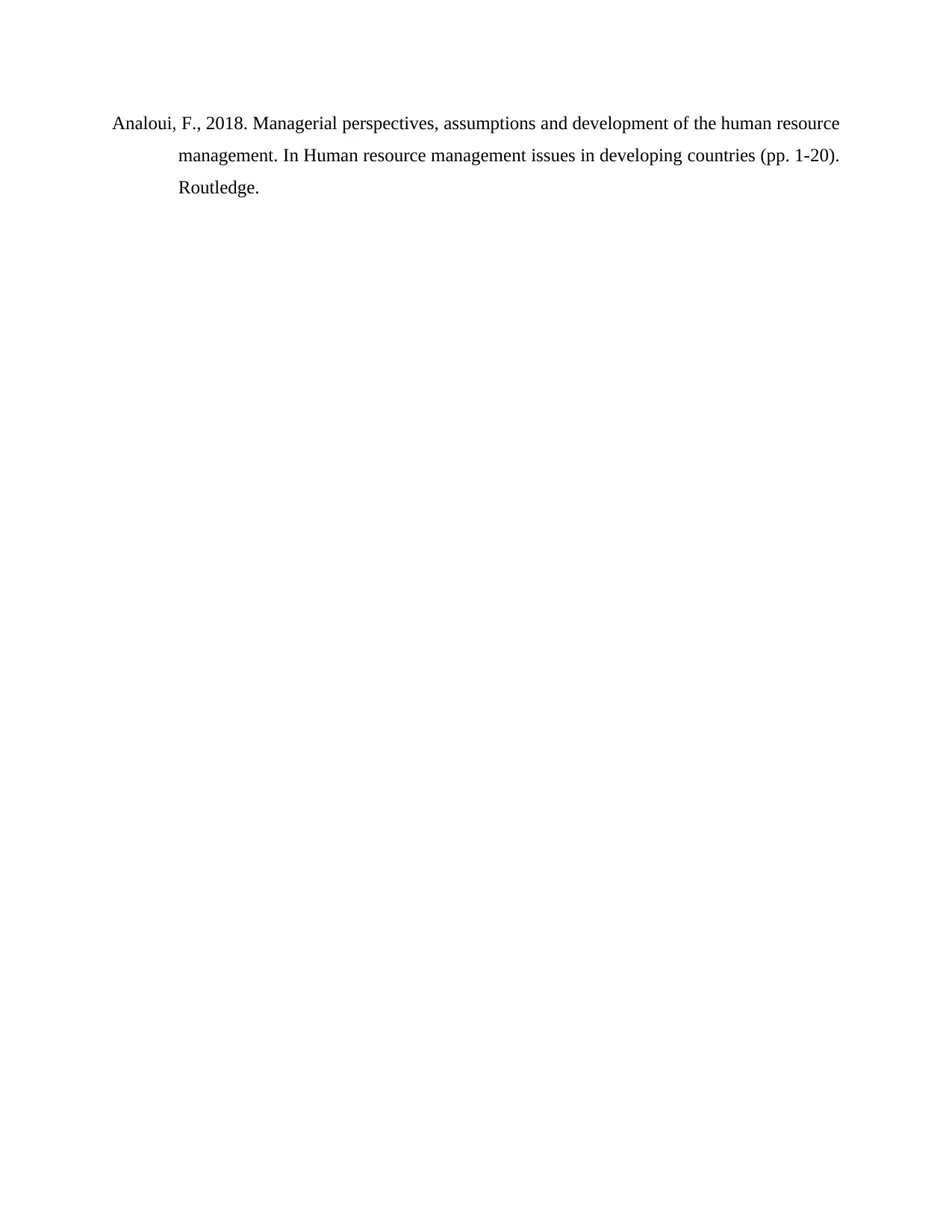
Analoui, F., 2018. Managerial perspectives, assumptions and development of the human resource
management. In Human resource management issues in developing countries (pp. 1-20).
Routledge.
management. In Human resource management issues in developing countries (pp. 1-20).
Routledge.
You're viewing a preview
Unlock full access by subscribing today!
1 out of 12
Related Documents
Your All-in-One AI-Powered Toolkit for Academic Success.
+13062052269
info@desklib.com
Available 24*7 on WhatsApp / Email
![[object Object]](/_next/static/media/star-bottom.7253800d.svg)
Unlock your academic potential
© 2024 | Zucol Services PVT LTD | All rights reserved.





